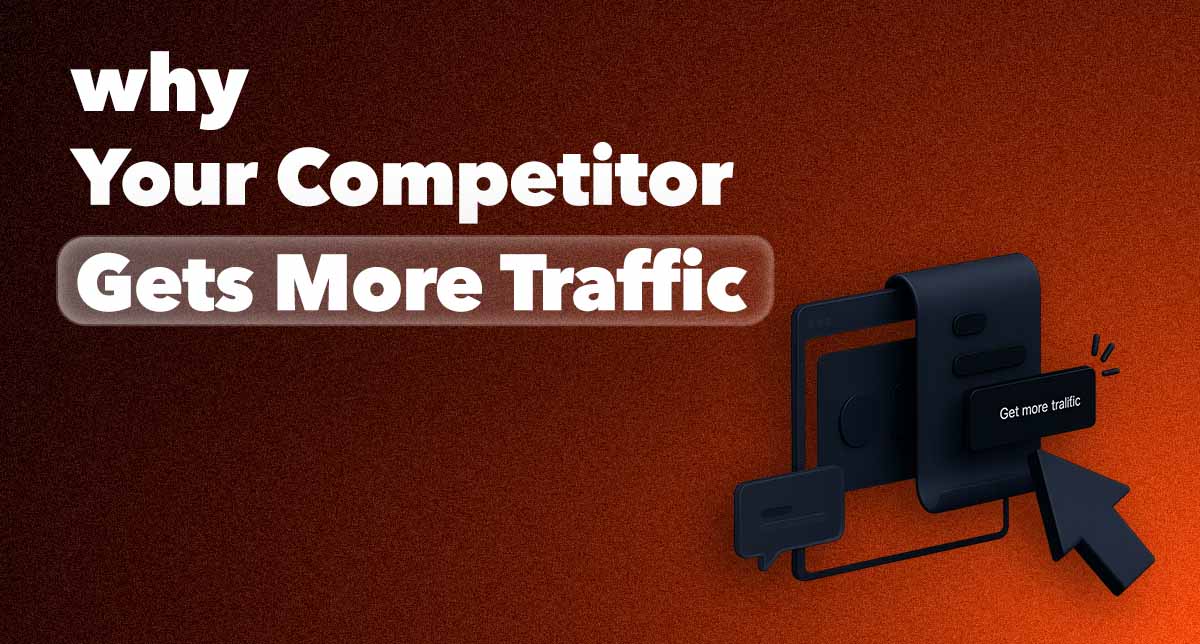If you’ve ever wondered why your competitor consistently ranks higher on search engines and attracts more visitors, you’re not alone. Whether you’re an eCommerce business, a local service provider, or a real estate agent, understanding why others are getting more traffic can be the key to improving your strategy. In this article, we’ll break down the key factors contributing to your competitor’s traffic success and provide actionable insights on how to catch up.


How Google Helps Them Get More Traffic Than You
Google’s algorithms prioritize high-quality content and relevant user experiences, which can make all the difference in why your competitor gets more traffic and you get left behind. Your competitors likely have mastered the art of aligning with Google’s ranking factors, from keyword optimization to mobile-friendliness and fast-loading websites. Google continuously refines its algorithm to reward businesses that create user-centric websites and quality content, ensuring that those who play by the rules get more visibility. Whether it’s optimizing for Featured Snippets, leveraging E-A-T (Expertise, Authoritativeness, and Trustworthiness), or adhering to Google’s Core Web Vitals, your competitor is likely reaping the rewards of keeping up with Google’s ever-changing standards. Staying on top of these updates ensures you’re not missing out on opportunities to appear higher in search results.
Top Channels That Help Them Get More Traffic
Understanding where and how your competitor gets their traffic is critical to shaping your strategy. Typically, top competitors leverage multiple digital marketing channels, which include:- Organic Search (SEO): Effective SEO strategies help businesses rank for high-volume keywords, driving consistent organic traffic over time. Your competitors may be optimizing their content and backlinks, improving site structure, and focusing on local SEO to stay ahead. If you want to take your SEO game to the next level and stay competitive, exploring our SEO services can help you implement the right strategies and boost your online presence.
- Paid Search (PPC/Google Ads): Google Ads provides immediate visibility and can help drive targeted traffic. Your competitor may be bidding on the right keywords, using ad extensions, and refining their targeting to gain an edge.
- Social Media: Social channels like Facebook, Instagram, LinkedIn, and Twitter can help drive a huge amount of traffic through targeted ads and organic posts.
- Referral Traffic: If your competitor is featured in industry directories or partner websites or is collaborating with influencers, they may be getting a steady stream of referral traffic.
- Email Marketing: Compelling newsletters and email campaigns can keep their audience engaged, prompting return visits to their website.
Do Ads or SEO Help Them Get More Traffic?
A key question to ask yourself is whether paid ads or organic SEO efforts are contributing more to your competitor’s traffic. Many businesses believe they need to choose between SEO and PPC, but in reality, both play a critical role in driving traffic.- Google Ads: PPC campaigns can drive immediate traffic, especially for high-intent keywords. If your competitor is using Google Ads, they may be gaining a competitive edge by capturing potential customers who are actively searching for the products or services they offer. Google Ads also allows for precise targeting, including geographic and demographic segmentation.
- SEO: While Google Ads may bring short-term results, SEO focuses on long-term growth by driving organic traffic. Organic search traffic often converts better, as it builds trust over time. Your competitor is likely investing in on-page SEO, content creation, link-building strategies, and local optimization.
What Kind of Content Gets More Traffic?
Content is the backbone of any successful online presence, and your competitor likely excels at producing the type of content that resonates with both search engines and users. Here’s a breakdown of content types that can drive traffic:- High-Value Blog Posts: Your competitor may regularly publish in-depth blog posts that answer user questions or solve specific problems. These long-form articles tend to perform well in search results, especially when optimized for SEO.
- Interactive Content: Quizzes, surveys, calculators, and other forms of interactive content can increase user engagement and encourage social shares, which leads to more traffic.
- Video Content: As video content becomes increasingly popular, your competitor may be leveraging YouTube and embedded videos on their website to attract more visitors.
- Case Studies & Testimonials: These pieces build trust and help to convert visitors into leads. Your competitor might use success stories or in-depth case studies that demonstrate their credibility.
The Technical Fixes That Quietly Get More Traffic
Technical SEO is one of those behind-the-scenes factors that might not be immediately visible but can have a huge impact on your traffic over time. Your competitor is likely optimizing their website in the following ways:- Site Speed Optimization: Google rewards fast-loading websites. If your competitor’s site loads in under three seconds, they are likely receiving higher rankings and, in turn, more traffic.
- Mobile Optimization: With mobile traffic accounting for a large portion of search activity, ensuring their site is mobile-friendly is crucial. Google prioritizes mobile-first indexing, meaning that if their site performs well on mobile devices, they gain an edge in rankings.
- URL Structure & Internal Linking: A clean URL structure and strategic internal linking are essential for SEO. By optimizing site architecture and ensuring users can easily navigate through related pages, your competitor makes it easier for search engines to index their content.
- Schema Markup: Adding structured data to their website helps Google understand the context of their content, which can lead to higher visibility in search results.

How to Discover Why They Get More Traffic
It’s frustrating to see your competitor getting more traffic, but luckily, you can find out exactly why they’re outperforming you. Some useful tools and tactics include:- SEMrush: This tool allows you to track your competitors’ keyword rankings, traffic sources, and backlink profiles.
- Ahrefs: Ahrefs can help you identify your competitor’s best-performing content and backlink strategies.
- Google Analytics: By monitoring your own website’s traffic and comparing it to industry standards, you can see what’s working and where you might be losing out.
- SpyFu: SpyFu helps you analyze the keywords your competitor is bidding on in Google Ads and also reveals organic search opportunities.
Easy Wins to Get More Traffic Starting Today
If you're feeling overwhelmed, don’t worry. There are some quick wins you can implement today to start seeing more traffic:- Optimize your Google Ads: Focus on high-intent keywords, tailor your ad copy, and use ad extensions for better visibility.
- Improve Your Content: Publish more engaging blog posts, videos, and case studies that address user pain points.
- Speed Up Your Website: Use tools like Google PageSpeed Insights to identify and fix site speed issues.
- Fix Technical Issues: Check for broken links, ensure mobile optimization, and implement schema markup.




